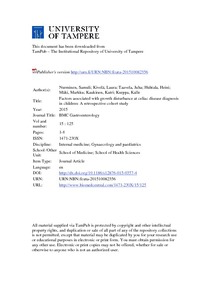Factors associated with growth disturbance at celiac disease diagnosis in children: A retrospective cohort study
Nurminen, Samuli; Kivelä, Laura; Taavela, Juha; Huhtala, Heini; Mäki, Markku; Kaukinen, Katri; Kurppa, Kalle (2015)
Nurminen, Samuli
Kivelä, Laura
Taavela, Juha
Huhtala, Heini
Mäki, Markku
Kaukinen, Katri
Kurppa, Kalle
2015
BMC Gastroenterology 15
125
Lääketieteen yksikkö - School of Medicine
Terveystieteiden yksikkö - School of Health Sciences
This publication is copyrighted. You may download, display and print it for Your own personal use. Commercial use is prohibited.
Julkaisun pysyvä osoite on
https://urn.fi/URN:NBN:fi:uta-201510082356
https://urn.fi/URN:NBN:fi:uta-201510082356
Kuvaus
BioMed Central open access
Tiivistelmä
Background
Impaired growth is a well-known complication in celiac disease, but factors associated with it are poorly known. We investigated this issue in a large cohort of children.
Methods
530 children with biopsy-proven celiac disease were included. The participants were divided into two groups on the basis of the presence (n = 182) or absence (n = 348) of growth disturbance at diagnosis. Histological, serological and clinical characteristics were compared between children with growth failure and those with normal growth. Further, patients with growth failure as the sole clinical presentation were compared to those with poor growth and concomitant other symptoms.
Results
Children with growth failure were younger (p < 0.001) and had lower hemoglobin (p = 0.016) and higher celiac antibody (p < 0.001), alanine aminotransferase (p = 0.035) and thyroid-stimulating hormone values (p = 0.013) than those with normal growth. Significantly associated with growth failure at diagnosis were age <3 years (OR 4.3 (95 % CI 2.5-7.5) vs older age), diagnosis before the year 2000 and in 2000–09 (OR 3.1 (1.8-5.4) and OR 1.8 (1.1-2.8) vs diagnosis in 2010–2013), presence of total and subtotal villous atrophy (OR 4.2 (2.5-7.0) and OR 2.0 (1.3-3.2) vs partial atrophy), severe symptoms (OR 3.4 (1.8-6.7) vs mild symptoms) and vomiting (OR 3.1 (1.5-6.3). The presence of abdominal pain reduced the risk (OR 0.5 (0.3-0.7)), while there was no effect of gender, diarrhea, constipation, other chronic diseases and celiac disease in the family. Children evincing poor growth as the sole clinical presentation were older (p < 0.001) and had higher hemoglobin (P < 0.001) and total iron (p = 0.010) values and lower TG2ab values (p = 0.009) than those with growth disturbance and other symptoms.
Conclusions
In particular young age and severe clinical and histological presentation were associated with growth disturbance at celiac disease diagnosis. Children with only poor growth are markedly different from those with other concomitant symptoms, suggesting different pathogenic mechanisms.
Impaired growth is a well-known complication in celiac disease, but factors associated with it are poorly known. We investigated this issue in a large cohort of children.
Methods
530 children with biopsy-proven celiac disease were included. The participants were divided into two groups on the basis of the presence (n = 182) or absence (n = 348) of growth disturbance at diagnosis. Histological, serological and clinical characteristics were compared between children with growth failure and those with normal growth. Further, patients with growth failure as the sole clinical presentation were compared to those with poor growth and concomitant other symptoms.
Results
Children with growth failure were younger (p < 0.001) and had lower hemoglobin (p = 0.016) and higher celiac antibody (p < 0.001), alanine aminotransferase (p = 0.035) and thyroid-stimulating hormone values (p = 0.013) than those with normal growth. Significantly associated with growth failure at diagnosis were age <3 years (OR 4.3 (95 % CI 2.5-7.5) vs older age), diagnosis before the year 2000 and in 2000–09 (OR 3.1 (1.8-5.4) and OR 1.8 (1.1-2.8) vs diagnosis in 2010–2013), presence of total and subtotal villous atrophy (OR 4.2 (2.5-7.0) and OR 2.0 (1.3-3.2) vs partial atrophy), severe symptoms (OR 3.4 (1.8-6.7) vs mild symptoms) and vomiting (OR 3.1 (1.5-6.3). The presence of abdominal pain reduced the risk (OR 0.5 (0.3-0.7)), while there was no effect of gender, diarrhea, constipation, other chronic diseases and celiac disease in the family. Children evincing poor growth as the sole clinical presentation were older (p < 0.001) and had higher hemoglobin (P < 0.001) and total iron (p = 0.010) values and lower TG2ab values (p = 0.009) than those with growth disturbance and other symptoms.
Conclusions
In particular young age and severe clinical and histological presentation were associated with growth disturbance at celiac disease diagnosis. Children with only poor growth are markedly different from those with other concomitant symptoms, suggesting different pathogenic mechanisms.
Kokoelmat
- Artikkelit [6140]
